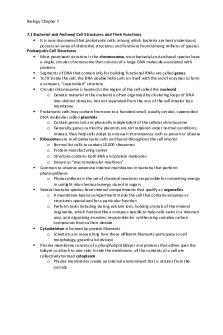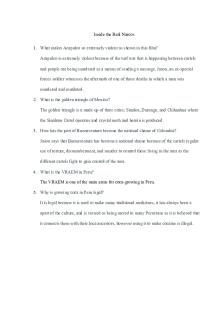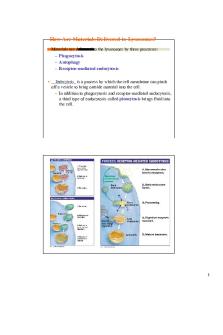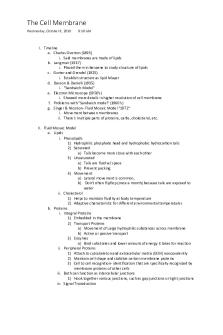Ch 7 - Inside the Cell PDF

| Title | Ch 7 - Inside the Cell |
|---|---|
| Course | Evolutionary Biology |
| Institution | Western Washington University |
| Pages | 7 |
| File Size | 125.8 KB |
| File Type | |
| Total Downloads | 32 |
| Total Views | 194 |
Summary
Download Ch 7 - Inside the Cell PDF
Description
Biology Chapter 7 7.1 Bacterial and Archaeal Cell Structures and Their Functions It is now discovered that prokaryotic cells, among which bacteria are best understood, possess an array of distinctive structures and functions found among millions of species Prokaryotic Cell Structures Most prominent structure is the chromosome, most bacterial and archaeal species have a single, circular chromosome that consists of a large DNA molecule associated with proteins Segments of DNA that contain info for building functional RNAs are called genes To fit inside the cell, the DNA double helix coils on itself with the aid of enzymes to form a compact, “supercoiled” structure Circular chromosome is located in the region of the cell called the nucleoid o Genetic material in the nucleoid is often organized by clustering loops of DNA into distinct domains, but not separated from the rest of the cell interior by a membrane Prokaryotic cells may contain from one to a hundred small, usually circular, supercoiled DNA molecules called plasmids o Contain genes but are physically independent of the cellular chromosome o Generally, genes carried by plasmids are not required under normal conditions; instead, they help cells adapt to unusual circumstances such as poison or disease Ribosomes are in all prokaryotic cells and found throughout the cell interior o Normal for cells to contain 10,000 ribosomes o Protein-manufacturing center o Structure contains both RNA and protein molecules o Known as “macromolecular machines” Common to observe extensive internal membranes in bacteria that perform photosynthesis o Photosynthesis is the set of chemical reactions responsible for converting energy in sunlight into chemical energy stored in sugars Several bacteria species have internal compartments that qualify as organelles o A membrane-bound compartment inside the cell that contains enzymes or structures specialized for a particular function o Perform tasks including storing calcium ions, holding crystals of the mineral magnetite, which function like a compass needle to help cells swim in a directed way; and organizing enzymes responsible for synthesizing complex carbon compounds from carbon dioxide Cytoskeleton is formed by protein filaments o Scientists are researching how these different filaments participate in cell morphology, growth and division Plasma membrane consists of a phospholipid bilayer and proteins that either span the bilayer or attach to one side. Inside the membrane, all the contents of a cell are collectively termed cytoplasm o Plasma membranes create an internal environment that is distinct from the outside
Biology Chapter 7 o Prohibit entry of many substances that would be dangerous to life while allowing passage of molecules and ions required for life o Bacterial phospholipids consist of fatty acids bound to glycerol while archaeal phospholipids use highly branched isoprenoid chains bound to glycerol o Cytoplasm is hypertonic to the surrounding environment due to high concentration of solutes The stiff cell wall resists pressure from water entering the cell via osmosis o Cell walls are a tough, fibrous layer that surrounds the plasma membrane o Protects organisms and gives them shape and rigidity o In most bacteria, peptidoglycan is the primary structural component of the cell wall, some include an outer membrane consisting of glycolipids Flagella and fimbriae grow from the plasma membrane. Archaea also have flagella and appendages similar to fimbriae but they are structurally distinct from those found on bacteria A prokaryotic flagellum is assembled from many different proteins at the cell surface of certain species o Molecular motor embedded in the plasma membrane o They rotate a long rigid filament to propel the cell through water o At top speed a flagella can drive a bacterial cell through water at 60 cell lengths per second A fimbria is a needlelike projection that extends from the plasma membrane of some bacteria o Promotes attachment to other cells or surfaces o Similar, but unrelated structures are found on archaea o These tend to be more numerous than flagella and may be distributed over the entire surface of the cell o Crucial to establishment of infections based on their ability to glue bacteria to the surface of tissues 7.2 Eukaryotic Cell Structures and Their Functions Eukaryotic domain includes species that range from microscopic algae to 100-meter-tall redwood trees Protists, fungi, plants, and animals are all eukaryotic Most prokaryotic cells measure 1 to 10 um in diameter, eukaryotic cells range from about 5 to 100 um in diameter Most eukaryotes ingest bacteria and archaea whole Eukaryotic cells are subdivided into compartments due to their large volume, the cytosol —fluid portion between the plasma membrane and these organelles—is only a fraction of the total cell volume Compartmentalization offers two key advantages o Incompatible chemical reactions can be separated o Chemical reactions become more efficient. First, substrates required for particular reactions can be localized and maintained at high concentrations within organelles. When substrates are
Biology Chapter 7 used up in a particular part of the organelle, they can be replaced by substrates that have only a short distance to diffuse Groups of enzymes that work together can be clustered within or on the membranes of organelles instead of floating free in the cytosol. When product of one reaction is the substrate for a second reaction, clustering the two enzymes increases the speed and efficiency of both reactions Eukaryotic cells resemble sprawling industrial complexes o Organelles and other structures are like highly specialized buildings that act as administrative centers, factories, transpiration corridors, waste and recycling facilities, warehouses and power stations Differences between prokaryotic and eukaryotic cells o Eukaryotic cells are generally much larger than prokaryotic cells o Prokaryotic chromosomes are in a loosely defined nucleoid region while eukaryotic chromosomes are enclosed within a membrane-bound compartment called the nucleus o The cytoplasm of eukaryotic cells is compartmentalized into a larger number of distinct organelles compared to cytoplasm in prokaryotic cells Eukaryotic Cell Structures: A Parts List The nucleus contains chromosomes and functions as an administrative center for information storage and processing o Largest, most highly organized of all organelles o Enclosed by a complex double membrane called the nuclear envelope Studded with pore-like openings, inside surface is linked to fibrous proteins that form a lattice-like sheet called the nuclear lamina Nuclear lamina stiffens the membrane and maintains organelle shape o Each chromosome occupies a distinct area Densely packed sections concentrated at the periphery and loosely packed sections toward the interior o Contains specific sites where gene products are processed and includes at least one region called the nucleolus, where RNA molecules found in ribosomes are manufactured and large/small ribosomal units are assembled Scattered throughout the cytoplasm of eukaryotes are ribosomes o Eukaryotic ribosomes are complex macromolecular machines that manufacture proteins o Ribosomes aren’t surrounded by membranes, so they aren’t organelles o Scattered free in the cytosol o Associated with organelle called the endoplasmic reticulum o Proteins manufactured by free ribosomes either remain in the cytosol or are imported into other organelles such as the nucleus Portions of the nuclear envelope extend into the cytoplasm to form an extensive membrane-enclosed factory called the endoplasmic reticulum (ER) o Continuous with the nuclear envelope
Biology Chapter 7
o Two distinct regions o Rough endoplasmic reticulum (RER) is named for its appearance of knobbylooking structures that are ribosomes attached to the membrane Ribosomes associated with the rough ER synthesize proteins that function in the ER or will be shipped to another destination, such as a different organelle, the plasma membrane, or secreted to the cell exterior Proteins move to interior of sac-like component of the rough ER Interior of the rough ER is called the lumen In the lumen of the rough ER, newly manufactured proteins undergo folding and other types of processing Some proteins carry messages to other cells; some act as membrane transport proteins or pumps; others catalyze reactions Many of the rough ER products are packaged into vesicles and transported to various distant destinations—often to the surface of the cell or beyond o Smooth endoplasmic reticulum (SER) is free of ribosomes and therefore is smooth and even Contains enzymes that catalyze reactions involving lipids May synthesize lipids or break down lipids and other molecules that are poisonous Smooth ER is the manufacturing site for phospholipids used in membranes Functions as a reservoir for calcium ions that can be released to trigger a wide array of activities inside the cell o Rough ER has ribosomes and functions primarily as a protein-manufacturing center; smooth ER lacks ribosomes and functions primarily as a lipid-processing center Proteins that leave the rough ER must first pass through the Golgi apparatus before they reach their final destination. o The Golgi apparatus consists of dozens of stacks of discrete flattened, membranous sacs called cisternae (singular: cisterna), which are stacked on top of each other like pancakes o The cis (side) surface is closest to the nucleus, and the trans (across) surface is oriented toward the plasma membrane o Cis side of the Golgi apparatus receives the vesicles containing rough ER products, referred to as cargo o Trans side ships them out to other organelles or the cell surface o As cargo moves through Golgi apparatus from the cis to trans surfaces, it’s processed and packaged for delivery o Micrographs often show “bubbles” on either side of a Golgi stack. These are membrane-bound transport vesicles that carry proteins or other products to and from the organelle Animal cells contain organelles called lysosomes that function as recycling centers
Biology Chapter 7
o Contain about 40 different enzymes, each specialized for hydrolyzing different types of macromolecules—proteins, nucleic acids, lipids, or carbs o Amino acids, nucleotides, sugars, and other molecules that result from hydrolysis are exported from the lysosome via transport proteins in the organelles membrane Once in the cytosol, they are used as sources of energy or building blocks for new molecules o Digest enzymes inside lysosomes are called acid hydrolases because they can use water to break monomers from macromolecules o Proton pumps in the lysosomal membrane maintain an acidic pH in the lumen of the lysosome by importing hydrogen ions o Lysosomes are physically separated from the Golgi apparatus and the endoplasmic reticulum but together they’re referred to as the endomembrane system The endomembrane system is a center for producing, processing, and transporting proteins and lipids in eukaryotic cells Ex: Acid hydrolases are synthesized in the ER, processed in the Golgi apparatus, and then shipped to lysosome Cells of plants, fungi, and certain other groups lack lysosomes and instead have a vacuole o Compared to lysosomes, vacuoles of plant and fungi are large—in plants sometimes taking up 80 percent of cell volume o Some contain hydrolases and play similar role to lysosome o Most vacuoles act as storage depots storing ions such as K+ and Cl-, drawing water in from the environment o As the vacuole expands in volume, the cytoplasm pushes the plasma membrane against the cell wall The effect of this change in volume is observed when wilted green plants regain their rigid structure after water is added to the soil o In seeds, cells may contain a large vacuole filled with proteins. Enzymes digest these proteins to provide amino acids for the growing seed o In flower petals or fruits, cells may contain vacuoles that are filled with colorful pigments o Elsewhere, vacuoles may be packed with noxious compounds that protect leaves and stems from being eaten containing toxins such as nicotine, morphine, caffeine, or cocaine Virtually all eukaryotic cells contain globular organelles called peroxisomes. o These organelles have a single membrane and originate as vesicles from the ER o Different cells from the same individual may have distinct types of peroxisomes, these organelles all share the same function o Peroxisomes are centers for reduction oxidation (redox) reactions o Peroxisomes in your liver cells contain enzymes that remove electrons from, or oxidize, the ethanol in alcohol beverages
Biology Chapter 7
o In leaves of plants, specialized peroxisomes called gloxysomes are packed with enzymes that oxidize fats to form a compound that can be used to store energy for the cell o In animals and plants, the products of these reactions often include hydrogen peroxide which is highly reactive If hydrogen peroxide escaped from the peroxisome it would quickly react and damage DNA, proteins and cellular membranes This is rare because enzyme catalase quickly “detoxifies” hydrogen peroxide by catalyzing its oxidation to form water and oxygen The organelle primarily responsible for supplying ATP in animals, plants and virtually all other eukaryotic cells is the mitochondrion (plural: mitochondria) o Each mitochondrion has two membranes Outer membrane defines the surface, inner membrane forms a series of sac-like cristae (singular: crista) Solution enclosed within inner membrane is called mitochondrial matrix o Chemical energy in carbs and fats is used to produce ATP in eukaryotes o Most enzymes and molecular machines responsible for synthesizing ATP are embedded in the inner membrane or suspended in the matrix o Number of mitochondria can range from one to more than a million o Each mitochondrion has many copies of a small, circular or, in some species, linear chromosome called mitochondrial DNA (mtDNA) that is independent of the nuclear chromosomes Mitochondrial DNA contains only a tiny fraction of genes responsible for the function of the organelle—the other genes reside in the nuclear DNA Most algal and plant cells possess an organelle called chloroplast, in which sunlight is converted to chemical energy during photosynthesis o Number of chloroplast per cell varies from none to several dozen o Surrounded by double membrane o There are no cristae extending from the inner membrane into the interior, like in the mitochondrion o A third membrane forms an independent network of hundreds of flattened, saclike structures called thylakoids throughout the interior Most thylakoids are arranged in interconnected stacks called grana (singular: granum) Many of the pigments, enzymes, and macromolecular machines responsible for converting light energy to chemical energy are embedded in the thylakoid membranes o Regions between thylakoid and inner membrane, called the stroma, contains enzymes that use this chemical energy to produce sugars o Each chloroplast contains copies of its own circular chromosome and small ribosomes that manufacture some, but not all, of the organelles proteins o Both mitochondria and chloroplasts also grow and divide independently of cell division
Biology Chapter 7 o Scientists believe mitochondria and chloroplasts were once free-living bacteria o The endosymbiosis theory states these bacteria were engulfed by the ancestors of modern eukaryotes but not destroyed—instead, a mutually beneficial relationship evolved Major structural feature common to all eukaryotes is the cytoskeleton o Extensive system of protein fibers that gives the cell its shape and structural stability o Involved in moving materials within the cell as well as the cell itself o Organizes all the organelles and other cellular structures into a cohesive whole o Prokaryotes also have a cytoskeleton, but it is far less extensive In fungi, algae and plants, cells possess an outer cell wall in addition to their plasma membrane o Located outside the plasma membrane and furnishes a durable, outer layer, that gives structural support to the cell o Cells of animals and amoebes lack a cell wall and only have a plasma membrane o Rods or fibers composed of a carbohydrate run through a stiff matrix made of other polysaccharides and proteins SEE PAGE 153 FOR FULL CHART OF STRUCTURE (MEMBRANE, COMPONENTS) AND FUNCTION OF THE CELL COMPONENTS...
Similar Free PDFs

Ch 7 - Inside the Cell
- 7 Pages

Chapter 7: Inside the Cell
- 10 Pages

Assignment 7 the cell factory
- 18 Pages

Inside THE REAL Narcos
- 1 Pages

Ch 7- the nervous system
- 15 Pages

Inside The Living Body Notes
- 3 Pages

Inside The Teenage Brain Letter
- 5 Pages

Inside the Cells II (3
- 19 Pages

Ch 7 QUIZ - Lecture notes ch 7
- 6 Pages

PLSC 111 Ch 7 The Bureaucracy
- 12 Pages

The cell cycle lecture
- 3 Pages

Ch-7 - Testbank Chapter 7
- 25 Pages

The Clara Cell
- 6 Pages

The Cell Membrane
- 2 Pages
Popular Institutions
- Tinajero National High School - Annex
- Politeknik Caltex Riau
- Yokohama City University
- SGT University
- University of Al-Qadisiyah
- Divine Word College of Vigan
- Techniek College Rotterdam
- Universidade de Santiago
- Universiti Teknologi MARA Cawangan Johor Kampus Pasir Gudang
- Poltekkes Kemenkes Yogyakarta
- Baguio City National High School
- Colegio san marcos
- preparatoria uno
- Centro de Bachillerato Tecnológico Industrial y de Servicios No. 107
- Dalian Maritime University
- Quang Trung Secondary School
- Colegio Tecnológico en Informática
- Corporación Regional de Educación Superior
- Grupo CEDVA
- Dar Al Uloom University
- Centro de Estudios Preuniversitarios de la Universidad Nacional de Ingeniería
- 上智大学
- Aakash International School, Nuna Majara
- San Felipe Neri Catholic School
- Kang Chiao International School - New Taipei City
- Misamis Occidental National High School
- Institución Educativa Escuela Normal Juan Ladrilleros
- Kolehiyo ng Pantukan
- Batanes State College
- Instituto Continental
- Sekolah Menengah Kejuruan Kesehatan Kaltara (Tarakan)
- Colegio de La Inmaculada Concepcion - Cebu

